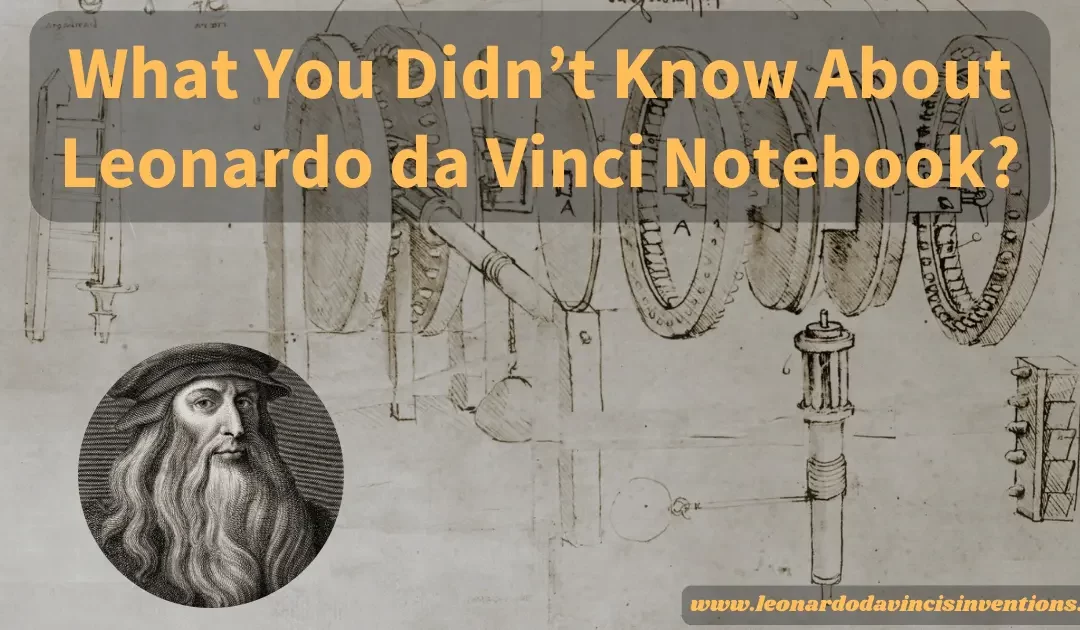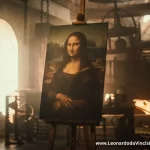
Leonardo da Vinci Notebook has fascinated people for centuries. Many are unaware of the secrets hidden in its pages.
These notebooks combine detailed sketches, scientific notes, and everyday observations, revealing the mind of a true Renaissance genius.
These journals offer a unique look at how Leonardo viewed the world around him. Most people know Leonardo as a painter and inventor, but his notebooks go far beyond art and machines.
He filled thousands of pages with ideas about anatomy, engineering, and even his grocery lists. These notes give us a window into his creative process.
These documents are seen as both works of art and valuable historical records.
The Genius Behind the Leonardo da Vinci Notebook
Leonardo da Vinci‘s Notebooks reveal much more than his famous art. These historical documents show deep curiosity and a drive for exploration in science, engineering, and anatomy.
He mixed careful observations with new ideas and inventions. Leonardo da Vinci was a remarkable figure of the Renaissance.
He was not just an artist, but also a scientist, engineer, and inventor. His interests ranged from painting to anatomy, mathematics, mechanics, and nature.
This wide range of skills and knowledge made him a true polymath. Leonardo saw connections between different fields.
He believed that learning about one area could help him succeed in another. For example, studying muscles and bones helped him paint realistic human figures.
His ability to connect art and science set him apart from others of his time. Using his notebooks, Leonardo explored ideas far beyond the limits of his day.
He reflected on the motion of water, flight, geometry, and even the structure of the human body. His drive to ask questions and find answers helped shape the Renaissance spirit of innovation and discovery.
How the Leonardo da Vinci Notebook Reflects His Multidisciplinary Expertise
The Notebook covers many topics and includes sketches, diagrams, and drawings. These personal notes show how he solved problems in art, science, architecture, and engineering.
He often filled a single page with both technical designs and nature studies. This blend shows how he combined the scientific method with creativity.
Leonardo made detailed diagrams of inventions, such as flying machines and hydraulic devices, next to studies of plants and animals. His observation journals contain step-by-step notes on how he worked through mechanical problems.
These included gears, pulleys, and studies of water movement. His notebooks reveal amazing mechanical designs, perspectives, architecture, and mathematics studies.
This multidisciplinary approach helped him innovate.
The Role of Curiosity and Experimentation in Leonardo’s Notes
Curiosity guided almost every page of his Notebooks. Leonardo da Vinci asked questions about how things worked and used careful observation to try new ideas.
He rarely accepted things as they were and always wanted to see if he could test or improve them. Much of his work is based on direct experimentation.
He learned by disassembling machines, drawing from nature, or studying living beings. His notes show lists of experiments and results, a process similar to the modern scientific method.
Leonardo also wrote observations about shadows, light, movement, and birds flying. He tried to discover natural patterns, often making guess-and-check studies to refine his ideas.
This drive for firsthand experience helped him make many discoveries. His work influenced both science and art for future generations.
Understanding Leonardo’s Artistic Process Through Sketches and Drawings
The Notebooks are best known for their vivid sketches and drawings. Leonardo da Vinci used his drawing skills to practice art and explore form, perspective, and function.
Each sketch often mixes studies of anatomy, motion, and light. These sketches reveal his famous paintings, such as Mona Lisa and The Last Supper.
His anatomy studies went beyond basic outlines. He dissected bodies and made detailed notes about muscles, bones, and organs.
These careful drawings informed his science work and the lifelike expressions and postures in his paintings. He also studied drapery, faces, and hands, focusing on the structure underneath.
His drawings of inventions, such as flying machines, war machines, and bridge designs, show both artistic imagination and mechanical skill. These pages helped him work out problems before building anything.
His notebooks provide a key window into his creative process.
The Intellectual Legacy of Leonardo da Vinci’s Manuscripts and Codices
Leonardo’s manuscripts and codices have become some of the most valuable historical documents in the world. They are preserved in libraries and museums and studied by experts in many fields.
These Notebooks give direct insight into Leonardo’s thinking. The Codex Leicester, for example, is famous for its mirror writing and deep thoughts about water, light, and astronomy.
Leonardo’s habit of writing backward, possibly because he was left-handed, adds a unique aspect to his manuscripts—a detail explored in reports by institutions like the New York Times.
Although his inventions never materialized, his ideas influenced countless inventors and scientists after him. The preservation and study of Leonardo’s Notebooks help keep his spirit of curiosity and creativity alive.
Exploring the Scientific and Artistic Content of the Leonardo da Vinci Notebook

Leonardo da Vinci’s notebooks reveal the mind of a true Renaissance polymath. These famous manuscripts hold various scientific observations, artistic sketches, mechanical designs, and mathematical diagrams.
Anatomy Studies and Observations: Bridging Art and Science
Leonardo da Vinci used his notebooks to explore human anatomy in detail. He performed dissections and then made accurate sketches of muscles, bones, and organs.
His drawings show the placement of organs inside the body and how joints move. These notebooks blend science and art; each sketch is factual and carefully crafted.
This approach helped him better understand how the body works, which he used to improve his paintings and sculptures.
The anatomical drawings are notable for their clarity. They show Leonardo’s belief in careful observation.
Historians recognize these studies as critical early examples linking science and art in a single work.
Mechanical Designs and Inventions: Engineering Marvels on Paper
The notebooks also contain many technical sketches and mechanical inventions. Leonardo drew plans for flying machines, early versions of the helicopter, weapons, bridges, and hydraulic pumps.
He often used lists and diagrams to explain how each part works. Although many of his designs were never built in his lifetime, they offer insight into his engineering skills and creativity.
His mechanical drawings show a deep understanding of mechanics and hydraulics. Some modern engineers study these documents because the ideas still inspire innovation in design and technology.
His work on mechanical inventions marks him as a pioneer in studying machines and engineering.
The Use of Mirror Writing and Its Purpose in Leonardo’s Notebooks
Leonardo da Vinci often wrote in mirror writing, starting from the right and moving left. He used this unusual method on almost every page of his notebooks.
There are several theories about why he did this. Some believe he wanted to keep his notes private or protect his ideas from copying.
Others think it was simply easier for him as a left-handed writer. This technique made his manuscripts unique and sometimes hard to read.
Mirror writing also adds to the sense of mystery surrounding his historical documents. It shows Leonardo’s desire to experiment with different methods and his willingness to set himself apart from other thinkers of his time.
Diagrams and Geometry: The Mathematics Behind Leonardo’s Creations
Leonardo used diagrams and geometric shapes throughout the notebooks to understand art and science problems. He explored ratios, symmetry, and perspective using triangles, circles, and other shapes.
Leonardo’s work with geometry helped him master techniques like linear perspective. This gave his paintings realistic depth and proportion.
He often wrote about mathematical concepts alongside his artistic plans.
His approach showed how science and mathematics can support artistic creativity. This blend is one reason Leonardo’s work fascinates artists and scientists today.
Nature, Perspective, and Techniques: Foundations of Leonardo’s Artistic Mastery
Leonardo filled his notebooks with close observation of nature. He studied how water moves, light and shadow fall, and plants grow.
He also experimented with different painting and drawing techniques. He took notes on mixing colors, creating hazy backgrounds (sfumato), and showing distance in a flat image.
His careful studies of perspective set new standards for art. He made lists and observations about how to place objects and figures to make a scene look realistic.
Leonardo da Vinci created observation journals that have become essential for understanding the artistic process. His sketches and notes combine philosophy, science, and technical skill.
The Lasting Impact and Preservation of the Leonardo da Vinci Notebook
Leonardo da Vinci’s notebooks changed how people understand the connection between art and science. Their unique blend of detailed sketches, mechanical designs, and scientific observations continues to inspire scholars and creators today.
Historical Documents and the Preservation of Leonardo’s Notebooks
Leonardo’s notebooks are some of the most valuable historical documents from the Renaissance period. He filled them with thousands of pages of personal notes, sketches, and diagrams across several codices, like the Codex Atlanticus and Codex Leicester.
Many of these notebooks survived in fragments. Over the years, collectors and museums worked to preserve them.
Today, leading institutions store and digitize these manuscripts to make them available for study. The process took centuries because pages were scattered and sometimes lost.
Preserving these old papers requires special care, as exposure to light and touch can cause damage. Museums now use modern technology to display Leonardo’s work while keeping the originals safe for future generations.
Insights into Leonardo’s Scientific Method and Technological Innovations
Leonardo recorded his experiments and discoveries in careful observation journals and writing methods. He wrote in mirror writing, which made reading difficult for others and helped him avoid smudging ink with his left hand.
His notebooks focus on the scientific method: observe, ask questions, propose ideas, test, and record results. Many pages contain diagrams and sketches of gears, levers, and complex machines.
Some of his ideas include early designs for helicopters, tanks, and bridges. His work combined mathematics, engineering, and art.
How Leonardo’s Studies Influenced Architecture, Hydraulics, and Flight
Leonardo’s architecture, flight, and hydraulics studies pushed technology forward during the Renaissance. His notes and drawings for churches, fortresses, and bridges used geometry and perspective to find better shapes and materials.
His interest in water led to careful studies of rivers, dams, and canals. He drew plans for machines that could harness water and prevent flooding.
Some of these designs influenced later engineers. He explored the rules of flight by closely observing birds.
His famous flying machine sketches show his effort to blend art, science, and nature in the search for human flight. Though his inventions did not take off in his lifetime, they shaped future ideas.
The Role of Observation Journals in Leonardo’s Continuous Exploration
Leonardo’s observation journals helped him develop ideas about anatomy, botany, geology, and mechanics. He drew bones, muscles, organs, and plants, combining careful study with art.
These sketches reveal beauty and a strong drive to understand how things work. His journals show how writing, drawing, and testing ideas over time can lead to better solutions.
By making quick diagrams and notes, Leonardo could look back on earlier thoughts and improve them. Students and scientists today use similar journal techniques.
They collect observations, document experiments, and reflect on what they learn. Leonardo, using his notebooks, helped make this a common practice.
Why the Leonardo da Vinci Notebook Remains a Source of Creativity and Knowledge
Leonardo da Vinci’s notebooks inspire new generations by capturing various interests and discoveries. Readers find entries on human anatomy, mechanical designs, light, perspective, and experimentation.
Leonardo’s combination of writing, drawing, and detailed observation offers a model for multidisciplinary thinking. Artists and scientists worldwide use his methods to spark creativity and pursue innovation.
With his notebooks now widely available online and in museums, people can explore Leonardo’s notes and see firsthand how curiosity and experimentation can drive progress.
Frequently Asked Questions
Leonardo da Vinci recorded thousands of pages of notes and drawings across many notebooks. His journals remain highly valued and are held in museums and collections worldwide.
What did Leonardo da Vinci write in his notebook?
Leonardo da Vinci wrote about anatomy, engineering, art, and observations of nature. His notebooks are filled with sketches, diagrams, and personal reflections.
These journals provide insight into how he thought and worked. They contain scientific plans and artistic studies.
How much is Leonardo da Vinci’s notebook worth?
The value of a da Vinci notebook can be immense. In 1994, Bill Gates bought the Codex Leicester, one of Leonardo’s notebooks, for about $30.8 million.
It remains one of the most expensive books ever sold.
Where is Leonardo da Vinci’s notebook today?
Some of his notebooks are in collections like the British Library and museums in Italy. The Codex Leicester is owned privately but is sometimes displayed in museums.
His remaining notebooks are preserved in institutions that focus on art and history.
Who owns the da Vinci notebook?
Ownership varies by notebook. The Codex Leicester, for example, is owned by Bill Gates.
Other notebooks are held by museums, such as the Victoria and Albert Museum in London, which has several of his works.
What unusual method did Leonardo da Vinci use to write his famous notebooks, mainly using?
Leonardo wrote most of his notes in mirror script, meaning the writing runs from right to left and can only be read using a mirror. This made his work more private and harder to copy.
What does mirror writing look like?
Mirror writing appears reversed, as if seen in a mirror. Letters are backwards, and words go from the right side of the page to the left.
It is readable only when reflected.
What do Leonardo’s notebooks show evidence of?
His notebooks show evidence of curiosity and creativity in many fields. They highlight his anatomy, motion, flight, engineering studies, and experiments with art techniques.
They reveal both observation and invention in each subject area he explored.
Where is Leonardo da Vinci buried?
Leonardo da Vinci is buried at the Château d’Amboise in France, which is marked as his final resting place.
Where is the Last Supper painting?
The Last Supper is in the Santa Maria delle Grazie Convent in Milan, Italy. It remains on the wall of the monastery’s dining hall.
How many notebooks did Leonardo have?
Leonardo produced around 50 notebooks. Only about 20 survive today.
Scholars estimate he created between 20,000 and 28,000 pages of notes and sketches across his lifetime.




 Leonardo Bianchi,
the creator of Leonardo da Vinci's Inventions.
Thank you for visiting
Leonardo Bianchi,
the creator of Leonardo da Vinci's Inventions.
Thank you for visiting